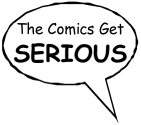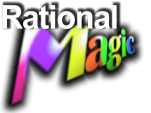Space Dog. By Hendrik Dorgathen. London: Andre Deutsch, 1993. 64p. n.p. ISBN 0-233-98850-5.
GENRES:
Science fiction; funny animalsAUDIENCE:
Adults, teens, older kids; dog sexSYNOPSIS:
This almost entirely wordless story is about a dog, whom we'll call Red Dog because he's bright red. He is born on a farm and passes his time doing doggy things. One day he hops on a train and is carried to the big city, where he finds survival difficult. Then he encounters Black Musician, who is sitting on a park bench, eating a sandwich. A softie, Black Musician can't resist Red Dog's begging, and he feeds the sandwich to Red Dog. Red Dog follows Black Musician home, and Black Musician takes him in. Then Black Musician goes to the club where he works, bringing Red Dog with him. While waiting in Black Musician's dressing room, Red Dog stops the doorman from stealing Black Musician's wallet and is kicked out of the club. Wandering despondently, Red Dog encounters a man walking a female dog (Tan Dog), and the two fall in love--but Red Dog is immediately captured by the dogcatcher and taken to the pound.Red Dog is sprung from the pound by a man from NASA and taken to the space base. He's going to be shot into space. The NASA scientists test him and design him a little doggie space suit. Up he goes! But as his rocket reaches outer space, it encounters an alien spacecraft. The NASA observers watch in horror as Red Dog's rocket vanishes from their screens, and the world gives up Red Dog for dead, including the sad Black Musician and his friends. In reality, however, Red Dog has been taken to the alien spacecraft by the benevolent aliens. Finding they cannot communicate with the animal, they enhance his intelligence to super-genius, then pass along a message to take back to Earth.
Red Dog's rocket reappears, to everyone's amazement, and splashes down in the ocean. Red Dog immediately greets his rescuers, which blows their minds, of course. He becomes an instant celebrity and is driven down the city streets in a ticker-tape parade. Black Musician rushes up to the car; Red Dog tries to embrace him, but Black Musician is set upon by security guards. Red Dog yells at them to stop, and he and the battered Black Musician leave the parade and go to Black Musician's apartment, where a "Welcome Home" party has been prepared. In the morning, a hung-over Red Dog gets a call from the President, and he tearfully departs Black Musician's residence for Washington.
Over the next few months, Red Dog becomes a mega-celebrity as he lectures on peace, the environment, and other advanced topics, cuts hit records, appears on TV and magazine covers, and poses for paintings. His image blankets the globe. Never forgetting his friend, he stays in touch with Black Musician via the phone. Elsewhere, Tan Dog pines for Red Dog when she sees him on TV.
Then, evil corporate forces plot to destroy Red Dog because of his anti-pollution, anti-money stance. They find him at Black Musician's apartment, getting slightly drunk and telling Black Musician how much he hates his new life. Red Dog remembers his old, peaceful farm life, and Black Musician asks him if he'd stay with him again. But after Red Dog gets a call from Evil Corporate Man asking him to endorse products (they want to corrupt him with money), Red Dog gets completely fed up and leaves. He finds Tan Dog being walked again, but this time her owner isn't willing to let Red Dog hang around. As Evil Corporate Man's henchmen close in, Red Dog manages to free Tan Dog, and they escape in a taxi, then jump on a train going to the country. They return to Red Dog's old farm home, where they settle down and have puppies. Red Dog wishes he was normal, but that's not to be. However, he can pretend; when the Farmer, who has his suspicions about his pet, catches Red Dog talking on the phone to Black Musician, Red Dog barks at him!
EVALUATION:
Such a charming little story, one of the relatively few wordless graphic novels out there. Actually, the characters speak in symbols. For example, when Red Dog's rocket reappears, the technician "yells" <rocket symbol> <Red Dog head>, and when Red Dog emerges from the space capsule, he says <waving hand>. These symbols effectively convey the major components of dialogue in about as minimalistic a fashion as possible. Yet the story is relatively deep, with its message about the value of friendship and family.The two main characters, Red Dog and Black Musician, are well fleshed out. Even before Red Dog is enhanced, you're rooting for him because he's such a cutie; he's loving and loyal to his friends but fierce to his enemies. After he's enhanced, he develops much more in the way of human characteristics--he walks on his hind legs, drinks, even starts smoking--but retains his earlier devotion to his friends. Black Musician could have been a stereotype but isn't; he's never shown as anything less than tender-hearted and a devoted friend of Red Dog (and, for that matter, so are his friends). The reader's indignation when Black Musician is attacked by the security guards is just as strong as Red Dog's.
The art is really cool--blocky, colorful, and old-fashioned (reminiscent of 50s-style comics), yet exceptionally expressive and arty. I loved so much of it--the two-page spread of the Mondrian-like painting of Red Dog, the sudden human expressions on Red Dog's face (he'd been pretty blank-eyed before that), the distortions the poor dog goes through when he blasts into space, the little dance he does when he realizes he can stand on his hind legs, etc. This is pure sequential art, the conveyance of information by pictures and their careful ordering. The art on the black characters is a little broad (very thick lips and pushed-forward faces), but they're treated so sympathetically that I didn't find it bothersome. (Some readers might, however, especially on a cursory inspection of the book.)
This book may be hard to find in this country. I got it in the Las Vegas Virgin Megastore as a remainder for two bucks. But it's worth a search; it's a good read, and I think it would be extremely instructive for sequential artists who want to explore styles that go beyond the standard superhero stuff. If nothing else, it's a supreme example of wordless storytelling. Highly recommended for most readers. The one quickie scene of dog sex (it's not real graphic) near the end might bug some parents, as might the occasional smoking or drinking scenes, but the book is otherwise fine for kids.
Copyright 2001, D. Aviva Rothschild Comments? Return to The Comics Get Serious main page Return to Rational Magic Current Issue Return to Rational Magic Home

